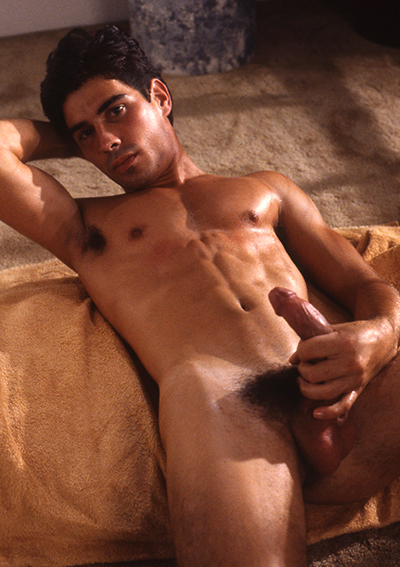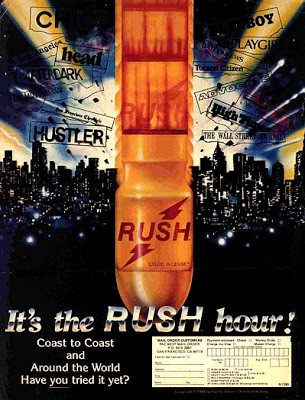Early ads for poppers in the late 1960s called them "aromas." At that time, aromatherapy was little known outside of France.
In 1969, outfits like JacMasters began to sell vials or "inhalers" containing isobutyl nitrite, and the first brand name was trademarked: Locker Room. Isobutyl nitrate, or amyl, is the original popper formula.
During the 1970s, poppers or "aromas" were marketed like a sexual incense to gay men. Rather than inhale the newly popular “aromas” of patchouli or sandalwood, gay men could inhale locker room or armpit scent, the smell of hot, rough, uninhibited sex. 
 Poppers had become so popular that, by 1977, The Wall Street Journal and Time Magazine claimed that the use of isobutyl nitrite as a recreational drug had become a substantial $50 million a year business.
Poppers had become so popular that, by 1977, The Wall Street Journal and Time Magazine claimed that the use of isobutyl nitrite as a recreational drug had become a substantial $50 million a year business.
And even more brands such Bolt, Hardware, Thrust, Quicksilver (not thunderbolt) were first introduced around 1977-78.
The Bijou started selling them around that time because the company (Great Lakes Products) that was making these poppers was renting space from us to manufacture their poppers These name brands were owned by Rush (someone named Joe Miller).
By the late 70s, the popularity of the drug even extended to straight men and women.
In the August 1979 issue of Playgirl, a "cautious" user's guide to drugs and sex reports that amyl nitrate intensifies orgasms but also smells like glue. The article reports that amyl was banned by the FDA and replaced by butyl, "which smells like old tennis shoes and is sold as a 'room deodorizer.'"
Old tennis shoes? Could be quite stimulating in certain situations, depending on your fetish. And that smell certainly does evoke the locker room, literally!
Some of the ads appealed to icons of masculinity: the traditional statue of David, harking back to pre-Stonewall gay bars, and the then-popular gay macho images of leathermen and cowboy.
The ubiquitous popper Rush was able to advertise in a plethora of gay publications; one famous add shows a giant bottle of “Rush” hovering over the “rush hour” of a city, which, in those days, didn't take place at the dusk of 5 p.m., but rather, in the late night and early morning hours (as implied in the image of the city) when the bathhouses and gay porn theaters were hopping.
 The popper bottle and the potent aroma one inhaled from it essentially powerfully rules from above but also, because it it releases an enveloping aroma, binds together the collective gay sexual culture represented by the titles of gay magazines (as well as straight, looking at some of the magazine titles in the ad) of that time together. It was more than a powerful tool or symbol of sexual liberation; it became sexual liberation itself.
The popper bottle and the potent aroma one inhaled from it essentially powerfully rules from above but also, because it it releases an enveloping aroma, binds together the collective gay sexual culture represented by the titles of gay magazines (as well as straight, looking at some of the magazine titles in the ad) of that time together. It was more than a powerful tool or symbol of sexual liberation; it became sexual liberation itself.
As the seventies progressed, the popper ads in gay magazines became more creative and catered to a variety of sexual tastes in this era of sexual liberation. For example, the ad for JacMasters in a 1976 Drummer Magazine shown below seems both campy and erotic.

The bulging jockstrap on one of the action figures harks back to the physique magazines like Physique Pictorial. Yet the hand holding what vaguely looks like a bottle by the logo probably represents a handjob. Big bottle equals big cock. Inhaling the aroma will make your cock big and hard. Or even like a giant cock to the little men holding the big bottle of aroma!
And the imagery of fighting and bullets (in the ad above, the guys look like little G.I. Joes) often found in the ads featuring poppers was most telling; at one level, it fed into the archetypal sex-death trope, but it also could be read in hindsight as a frightening prefiguration of AIDS, when sex literally caused death. And now the gigantic brown bottle over the city in the Rush ad now becomes something a bomb or a missile.

 In the 80s, the AIDS epidemic swept away the sexually-charged gay culture of the 70s that created and responded to the popper ads, but poppers themselves went underground (unfortunately, in many cases, in fake, or non-amyl, formats). The mainstream gay press, because of the possible connection between HIV and the use of nitrate, eventually stopped running ads for poppers, but not after a struggle.
In the 80s, the AIDS epidemic swept away the sexually-charged gay culture of the 70s that created and responded to the popper ads, but poppers themselves went underground (unfortunately, in many cases, in fake, or non-amyl, formats). The mainstream gay press, because of the possible connection between HIV and the use of nitrate, eventually stopped running ads for poppers, but not after a struggle.
According to one source, “before the first official reports of AIDS in 1981, relatively few voices in the gay community had been raised to question what health problems poppers users might be causing themselves. A few attempts were made to curb sales, but the manufacturers always got around it by changing either the chemical formula or the product name. And the gay press, dependent on revenue from ads, did not care to blow the whistle on its own advertiser.”
Frighteningly, information linking popper use to karposi's sarcoma was apparently suppressed by both the gay media (because of the power of the advertisers) and by the right wing press, which of course saw AIDS as a deserved punishment for promiscuity.
 The FDA at first stood aside; as long as poppers were marketed as “room perfume for fags,” they would do nothing.
The FDA at first stood aside; as long as poppers were marketed as “room perfume for fags,” they would do nothing.
And one popper manufacturer even sent a letter to all the gay papers, reminding them just who was "the largest advertiser in the Gay press."
Then, upon the instigation of some activists and researchers in the mid-eighties, Congress passed a law outlawing the original amyl nitrate formulas; now the major ingredient is butyl.
There are numerous poppers being distributed under different names, and most people have their favorites: for example, Rush and Brown Bottle are old standbys for most people who first buy poppers (not taking away from long-time users that only like these brands); as time went on, people graduated to other brands.
Regarding false types of poppers, for example, Can Opener, Private Stock, Platinum, and others, are truth are the same formula as Brown Bottle, but in different packaging, done to deceive people. Other current brands such D&E, Nitro, Zap, Man Scent, and Mr. Wonderful, will give people headaches; their manufacturers produce them to make money, not caring about quality and the intended purpose of the product.
About three years ago, the outfit that made the popper brand Rush was raised by the police. Supposedly, Joe Miller, the long-time manufacturer, committed suicide (this cause of death cannot be verified).
Six months ago, the story was circulating that someone had bought out the company. The outfit was back again selling its authentic product.
Will poppers ever become as “poppular” as they were in the 70s and 80s? As activities that were once part of the sexual underground become more mainstream in the 21st century, perhaps poppers in their true form will become once again become an exciting but now safe part of our diverse sexual culture.


























 Join our Email List
Join our Email List Like Us on Facebook
Like Us on Facebook Instagram
Instagram Youtube
Youtube Follow Us on Twitter
Follow Us on Twitter Follow us on Pinterest
Follow us on Pinterest